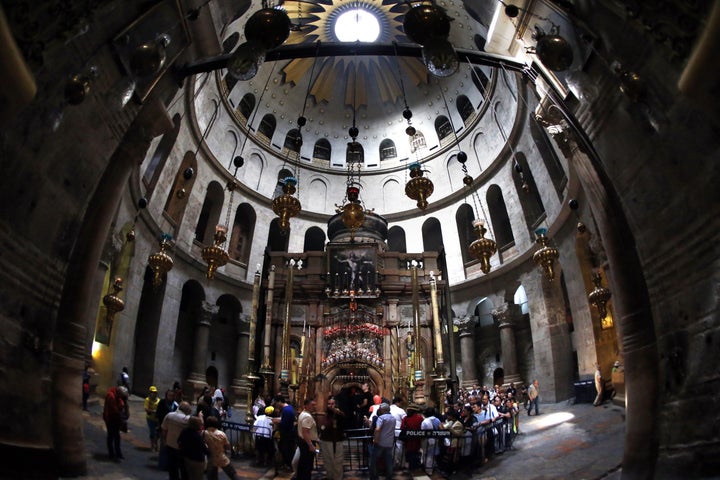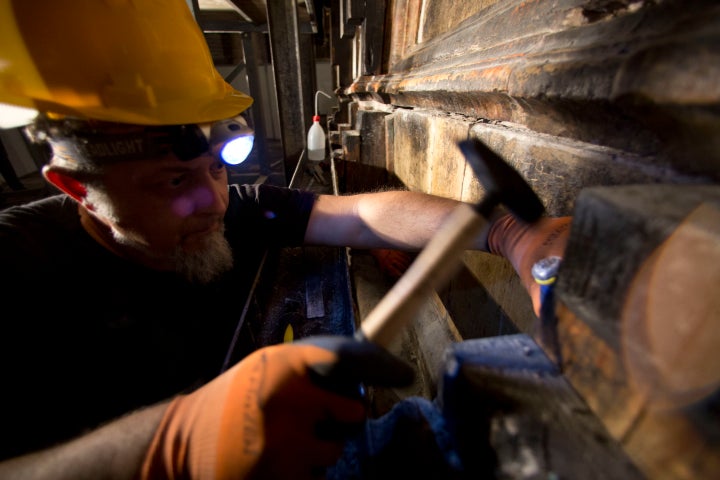The tomb believed to have belonged to Jesus is undergoing the first restoration work for 200 years after different denominations managed to put their differences behind them.
Renovations to the Church of the Holy Sepulchre in Jerusalem have begun to reinforce the Edicule.
An ornate structure with hanging oil lamps, columns and oversize candlesticks, this was erected above the spot where Christian tradition says Jesus' body was anointed, wrapped in cloth and buried before his resurrection, the Associated Press reported.

It stands a few hundred metres away from what it believed to be the site of Jesus’ crucifixion.
With its stone staircases, gilded ornamentation and many dark chambers, the church is one of Christianity's holiest shrines.
But that hasn't stopped different denominations from arguing over the site.
The Roman Catholic, Greek Orthodox and Armenian churches are responsible for maintaining separate sections, and each denomination carefully guards its domain. While the clergymen who work and pray at the church generally get along, tensions can rise to the surface.
In 2008, an argument between Greek Orthodox and Armenian monks erupted into a brawl.
Now, however, the clergymen have put aside their differences - a reflection of the dire need for the repairs.
Each denomination will contribute to the overall $3.3million (£2.3million) cost.
In addition, Jordan's King Abdullah, one of the world's most influential muslims, made a personal donation. Jordan controlled Jerusalem's Old City until the war in 1967, and the kingdom continues to play a role safeguarding Muslim and Christian holy sites.

Antonia Moropoulou, an architect at the National Technical University of Athens, which is supervising the renovation, noted the intricacy of the historic effort.
"Nobody envies this responsibility and challenge," she said. "Because, it is a challenge to work here in this ambient of an open monument visited by thousands of people daily."
Moropoulou said the tomb is stable, but needs urgent attention after years of exposure to environmental factors like water, humidity and candle smoke.
"The marble and stone slabs have developed, due to the stresses, some deformations," she said. In addition, the structure needs to be protected from the risk of earthquake damage.
Even an iron cage erected around the Edicule by British authorities in 1947 cannot bear the stress. "So another solution is needed," Moropoulou said.
The project will bolster the structure by, among other things, replacing the mortars and strengthening the columns. It is expected to take eight to 12 months, during which time pilgrims will be able to continue visiting the site.
Some of the work will be done in the early morning hours or late at night, when the church is closed. This quiet atmosphere will make it easier for experts to concentrate on the delicate task and help avoid disruptions for the thousands of pilgrims and tourists who visit each day.

The Reverend Athanasius Macora, a Franciscan monk who represents the Catholics at the inter-church commission that negotiates disputes at the Holy Sepulchre, said the renovation might have been more ambitious if not for the status quo rules.
He said: "I personally would have liked to maybe contemplate some alternative to simply restoring the current structure. But because the status quo is so conservative in its nature . we had to more or less accept the fact that there would be no change whatsoever to the current structure, and it would be restored as it is now."
Still, for pilgrims like Italian Claudio Pardini, the restoration is "an important sign" that all of the Christian churches are getting together to preserve their faith's traditions.
"It's good to take care of our churches so that we can leave the next generations a sign, something to visit," he said. "Because Christ isn't an idea. He's a story."
